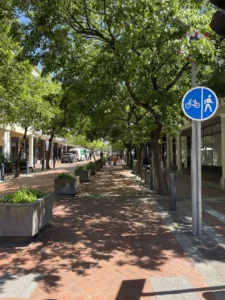Cape Town: The Walking and Cycling Strategy of the City of Cape Town is approved by the Council officially. The Urban Mobility Directorate of the municipality seeks to overtime reposition walking and cycling safe, accessible sustainable and primary modes of transport in Cape Town.
The approved strategy is a long-term plan that supports the investment in pedestrian and cycling improvements. This also promotes access to opportunities and integration of transport in Cape Town.
Member of the Mayoral Committee for Urban Mobility – Councillor Rob Quintas said that a car-centric approach is unsustainable for future growth in the Mother City. While putting efforts to make Cape Town moving, they need to adopt a bold shift towards active mobility, especially by walking and cycling.
These kinds of modes play a critical role in supporting public transport systems and the overall integration of transport in Cape Town.
However, the infrastructure of Cape Town is not designed to prioritize pedestrians and cyclists. The Walking and Cycling Strategy will further outline Cape Town’s commitment to create a more inclusive, people-focused transport system. It repositioned walking and cycling as primary, safe and sustainable modes of transport.
Through this strategic planning, the City of Cape Town can use the strategy to reshape the current landscape. The address existing gaps in infrastructure, integrate active mobility into urban design, and enhances collaboration across government bodies to achieve long-term, sustainable transport solutions.

Although, the City of Cape Town has brought significant progress in enhancing walking and cycling infrastructure, yet much more is needed to meet the demands. Walking remains the most common mode of transport for lower income households particularly, when cycling is providing a cost-effective and healthy option. Still, both modes face challenges due to inadequate safety and accessibility.
Moreover, the city has a body of existing planning interventions and a successful track record of implementation for active mobility.
Nevertheless, the network remains incomplete, fragmented, and overall insufficient in meeting the needs. In pursuing a sustainable transport system, a more holistic and integrated strategy is required, which recognizes walking and cycling as a key strategy, taking forward.
Councillor Rob Quintas added to his statement that walking and cycling require continuous and safe networks by prioritizing infrastructure around key precincts and at public transport interchanges.
Notably, high-demand cycling routes will be crucial. Targeted investments in these areas will then increase mobility, safety and accessibility. Creating highly pedestrianized precincts and cycle highways will offer complete, safe walking and cycling routes that actually have the potential to reduce traffic.
First off, the strategy will focus on strengthening partnerships to raise awareness and improve road safety for pedestrians and cyclists. This will refocus on the existing network and infrastructure planning programmes of the City of Cape Town.
Considering the long-run commitment for the implementation of the strategy will reform transport planning and design to prioritize walking, cycling and public transport over private vehicles with a vision to achieve people-centric city on a metro-wide scale, where walking and cycling are the most preferrable modes of transport.

